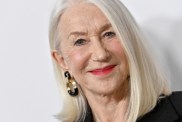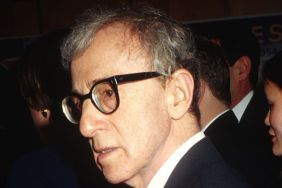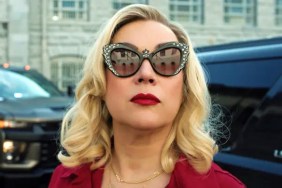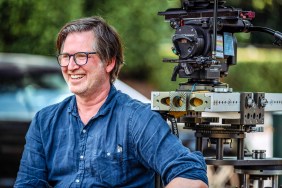
SHOCK’s David Bertrand does the distance with writer/director Steve De Jarnatt about his apocalyptic cult film MIRACLE MILE.
After ten years in gestation, MIRACLE MILE finally nuked theatres in 1989. The ultimate apocalyptic romance, as Anthony Edwards races in desperation to find his new beau in and around Los Angeles Miracle Mile with nuclear war looming, this project consumed writer/director Steve De Jarnatts life for the entire 1980s decade. With the vibrant colour scheme and Tangerine Dream score and haircuts marking the era, MIRACLE MILE embodies the fatalism of the meaty 1970s. Its a perfect mixture of urgent hope and shocking tragedy and one of the best films of the decade.
Anthony Edwards (hot from TOP GUN) plays Harry Washello, a visiting trombonist performing in Los Angeles at a charity rally for the Pan-Pacific Auditorium (in what was to be the iconic buildings final film appearance, as it burned down soon after the shoot). While killing time at the nearby La Brea Tar Pits & Museum, he meets Julie (Mare Winningham) and falls madly in love over the course of one carefree afternoon. Planning to meet her after her nightshift at Johnies Coffee Shop, a power outage zaps Harrys alarm clock and he shows up four hours too late. Dejected, the phone booth outside Johnies rings and Harry decides to pick it up, the only person privy to a conversation he should never have heard: nuclear war is imminent. America is launching nukes on the Soviet Union and the counterstrike which will hit in approximately one hour and ten minutes will flatten Los Angeles. From here on the film plays out in nearly real time, as Harry attempts to rally the diner patrons, find Julie, and escape Los Angeles before the coming Armageddon.
With a Blu-ray release of MIRACLE MILE now available from Kino Lorber who have also put out De Jarnatts other feature directorial effort, CHERRY 2000 (1987) a bizarre sci-fi desert actioner starring Melanie Griffith as a gun-for-hire helping David Andrews retrieve his fave living sex doll from deserted Las Vegas the time has never been better to enjoy Steve De Jarnatts films the way they should be seen. Graciously going above and beyond to make himself available, De Jarnatt is flying up to Toronto this coming November 12th for a rare 35mm print screening of MIRACLE MILE at the fabulous Royal Cinema as part of the ongoing Neon Dreams film series (recently knocking it out of the park with screenings of STREETS OF FIRE and PHANTOM OF THE PARADISE). The 35mm print is courtesy of Rui Pereira of the Kingsway Theatre.
Its also a bit of a homecoming, as MIRACLE MILE premiered at the Toronto International Film Festival back in 1988. De Jarnatt also got his major industry break in the Great White North as the screenwriter and for a time, attached as director! of STRANGE BREW (1983), starring SCTVs consummate Canadian hosers Bob & Doug McKenzie (Rick Moranis and Dave Thomas).
De Jarnatt was born in Colorado but grew up in the small town of Longview, Washington (where the father of Brian Thompson, who plays the helicopter pilot in MIRACLE MILE, was Steves oceanography teacher), before moving to Los Angeles where he made his home for some 40 years. MIRACLE MILE ended up being De Jarnatts second and last feature film as director, though he wrote, directed or produced 70-80 episodes of television starting in the 1990s. Currently, Steve is a Visiting Assistant Professor of Film in the MFA film program at Ohio University in Athens, largely retired from the film & television business to write award-winning fiction and has been happily making the rounds doing interviews and hosting screenings of MIRACLE MILE since its Blu-Ray release. Pick it up, enjoy the restored image supervised by cinematographer Theo van de Sande, and check out the cast reunion of character actors (O-Lan Jones, Earl Boen, Kurt Fuller, Denise Crosby, Brian Thompson, Danny De La Paz, Jenette Goldstein and more) at the iconic Johnies Coffee Shop where Anthony Edwards Harry receives a phone call heralding the end of the world as we know it.
SHOCK: MIRACLE MILE is special, in no small part because its one persons singular vision you made a studio picture the way you wanted, without anybody stamping over your vision. How did you know that the concept for MIRACLE MILE was the one to hold so tightly to your chest for so long?
SDJ: I think probably because of the subject matter. When I started doing it, the Cold War was still on, and I just wanted to shake the world up. By the time it was actually in a theater it was maybe almost ten years from the time I pitched it to the time it was done. And now its 25 years later. Im glad I stuck to my guns, or you wouldnt be talking to me. MIRACLE MILE was in the first 10 Best Unproduced Scripts in Hollywood list. So, it was a script that a lot of people wanted to do.
SHOCK: The 10 Best is a major Hollywood tradition you were in the very first list?
SDJ: Yup, the very first time, with TOTAL RECALL and JACOBS LADDER, and some other stuff that got made. And I dont know if I want to make another movie, but I made the second list with HAIR OF THE DOG, a really dark sort of ACE IN THE HOLE, MIDNIGHT COWBOY western set in Nashville in 1965. HAIR OF THE DOG made the second list. I dont know if I want to direct it or get somebody else to direct it, but the town that Im in is really old and it could maybe pass for Nashville in 1965. Well see. I dont know if Im personally into it anymore. I dont listen to any new country music, only way in the past. But its got good roles.

SHOCK: How did the ball get rolling on MIRACLE MILE?
SDJ: I went in and I pitched the idea of MIRACLE MILE to Mark Rosenberg who was the head of production at Warner Brothers (Marks brother Alan is part of the ensemble of diner actors in MIRACLE MILE this meeting is discussed in the Johnies cast reunion on the Blu-Ray). I pitched him the idea: What would you do if that phone rang? They liked the script, they wanted to make it. They wanted to probably change the ending, and they wanted to put more writers on it, to have me work with some big time writers. And then it was going to be expensive to ever get it back. So they let me have it back for a year, for free, and then I optioned it a couple years to control it. And then it was either I could buy it, or somebody else could buy it. And I had been on STRANGE BREW, I wrote the first draft in like ten days. They actually hired me to direct STRANGE BREW, I had a contract to direct it. They (stars Rick Moranis and Dave Thomas) were going to direct it anyways, but I got paid $50,000 to not direct the movie. And I gave every cent, after agent fees and taxes, to Warner Brothers and bought my MIRACLE MILE back just before somebody else was going to buy it. So I thank STRANGE BREW and all of Canada for that.
SHOCK: Im happy to take credit! Can you tell us first about the films you made leading up to MIRACLE MILE, starting with the black and white TARZANA (1978), that really looks like a film noir from the 1940s or 50s?
SDJ: That was sort of the idea, to make something that looked like it was shot in 1958. We used old cameras and lenses, and it does come close to that. Its sad and weird that its so long in the past. When I made it, in 1978, it was looking twenty years in the past. Now its 37 years or something since I made TARZANA! I also made a film its probably more the other guys movie, Jim Cox we made a fake documentary, EAT THE SUN (1975), which won awards as a documentary! We made up our own religion and shot it in Evergreen College in Olympia, Washington.
SHOCK: Your movie about The Temple of Self-Amplification won awards as a true fact documentary?
SDJ: Yeah. PBS bought it, and ran it once, and people called up and wanted more information on the church. They wanted to join the church. So they never ran it again. And I guess we wanted to put that out there too, as if this is a real documentary. Some journalists were going to write articles and sort of plant Internet stuff as if there really was a Temple of Self-Amplification if you move to Iowa or Brazil or something. I mean, theres enough jokes in it that you should be able to get that its not real, but
SHOCK: It almost benefits from what looks like a transfer from 16mm to VHS to YouTube, the dirty found footage look adds to its conviction that it might be real.
SDJ: Exactly. I get co-credit as a writer & director but its really Jim Coxs movie. He stuck with it and edited it, while I went back to L.A. He worked with Terry Malick on DAYS OF HEAVEN, and actually I did too, I was the projectionist. Jim was sort of Terrys right hand protégé. Hes gone on to do a lot of Disney animation and stuff like that (including writing the screenplay for FERNGULLY: THE LAST RAINFOREST, which inspired James Camerons AVATAR). After that I went to the AFI as a screenwriter. People liked TARZANA, but it was a genre movie and that wasnt cool, so I dropped out. I spent two and a half years making that. Four complete different shoots, with three different cameramen.
SHOCK: And this all went into the final product?
SDJ: Yeah. It was the same gaffer, Chris Tuffy and he was also the last credited DP. But you know, you go raise money, and you shoot it. Martin Brest (later famous for BEVERLY HILLS COP, SCENT OF A WOMAN) had made an AFI film called HOT TOMORROWS 70 minutes, 35mm, black and white, a lot of the same crew worked on TARZANA with Oingo Boingo and Ray Sharkey. Everybody in Hollywood came to see that and I was the opening band. So then I had all these agents who wanted to sign me, and I turned down movies for about four or five years. Until I did CHERRY 2000 which probably wasnt it wasnt good for my career.
SHOCK: What movies did you turn down?
SDJ: The first Pee-Wee Herman movie. Some guy named Tim Burton did it, I dont know whatever happened to him? POLICE ACADEMY, I dunno. I was always attached to movies, but I was always trying to get MIRACLE MILE made. I turned down all kinds of stuff.

SHOCK: What made you settle on CHERRY 2000? Its really an odd choice.
SDJ: That was a weird deal where I was getting ready to make MIRACLE MILE for two million with Nic Cage. They were actually doing the banking, and the head of Orion, Mike Medavoy, sent over the script of CHERRY 2000 and said, Youve got to do this movie. I think Irvin Kershner (THE EMPIRE STRIKES BACK) had just fallen out. And you know, they were desperate to get a director. They were already into production design, already kind of rolling. And I said no, forget it, Im doing MIRACLE MILE with Nic. And then about an hour later Nics attorney who was Francis Ford Coppolas attorney called up and said, Were pulling Nic out of MIRACLE MILE, hell do that in about a year and a half. Hes going to do PEGGY SUE GOT MARRIED and a couple other movies, and then well slot you in. And I couldnt get a hold of Nic. They said hes out in Catalina Island without a phone thats the way it is, kid! So I called up Mike Medavoy and said send the script over. I read about twenty pages and thought, This is weird. And I jumped on a moving train, and never caught up. I mean, we got some great character actors, and theres a lot of talent on the movie, but its a weird movie. Im glad it has a cult following.
SHOCK: The cinematography and design is excellent. Its a batshit crazy action movie. And it has some great performances Melanie Griffith is great. And Ben Johnson is so cool as the old tracker guru Six Fingered Jake.
SDJ: Ben Johnson, yes. Character actors, the costumes, and the music. Basil Poledouris was really great. Its a really weird movie but it has its charms. Ive been quoted before as saying Its PLANET OF THE APES but without the apes. Now its championed as a feminist manifesto because it was about giving up your sex doll for a real complicated woman. But I dont know if I quite get that. Speaking of CHERRY 2000, theres a guy, Ant Timpson who just came out with a movie, TURBO KID, that I heard is really good. He showed it at a theater in New Zealand. He ran CHERRY 2000 for five months! It never even played in Los Angeles. He ran it in a theater for five months! It shocks me that anyone from New Zealand which is not Australia, as I well know, but this applies to Australians too compared to ROAD WARRIOR, CHERRY is nothing! Im a pimple on the face of the Earth. But people like it.
SHOCK: I think Melanie Griffith really makes it work. You want to watch her every moment shes on the screen. CHERRY 2000 is a lot of fun.
SDJ: Im glad people like it. It sort of ruined my career, and it resurrected with MIRACLE MILE. I had done that Hitchcock thing with Melanie before.
(Steve wrote and directed an excellent episode of the 1980s revival of ALFRED HITCHCOCK PRESENTS, remaking the classic episode Man From the South starring John Houston, Melanie Griffith, Steven Bauer, Tippi Hedren and Kim Novak!)
SHOCK: Did that lead to Griffith being in CHERRY 2000?
SDJ: Yeah, pretty much, because wed worked together. Man From the South was my first professional job. Between TARZANA in 1978 and the Hitchcock thing in 1985, I just turned stuff down or got ready to film MIRACLE MILE. So thats like seven years of not doing anything. And MIRACLE MILEs production is still another four years after that.

SHOCK: Was MIRACLE MILE always in some form of development?
SDJ: Yeah. There was one incarnation with Mike Medavoy where we were going to make MIRACLE MILE with Kurt Russell and a bigger budget. Didnt work out. John Daly, the head of Hemdale (the film production and music management company founded by Daly and actor/director David Hemmings, who genre fans will know as the lead in Dario Argentos DEEP RED) actually financed the movie. Hes gone now (John Daly died in 2008), but hes a fascinating figure. You look at Hemdales library, they made THE TERMINATOR, HOOSIERS, RIVERS EDGE, PLATOON, SALVADOR. He won the Oscar for Best Picture two years in a row for PLATOON and THE LAST EMPEROR. And hes pretty notorious for taking your film away from you and chopping it up. And even more notorious for never giving you a penny of what youre entitled to. But I kept spending my own money, and shooting, and retooling and tweaking the film. And hed give me some money back and Id spend it. There was a lot of pressure to do the film on the budget we had, which was not very much, $3.7 million below the line. So I just kept working on the movie until I couldnt borrow another dime. But John Daly did end up really supporting it. I was probably the only person who made a movie with John Daly that would talk to him in later years. James Cameron and Oliver Stone, he probably owed them millions, tons of money. I was owed like $300,000-$400,000. MIRACLE MILE, even though it didnt do much box office, on video it did very well. So there were deferred payments or residuals and stuff like that. I never got them. They went bankrupt.
SHOCK: The location is so crucial. Did you always have it set in that same geographic radius of the Miracle Mile in Los Angeles?
SDJ: It always started at the Tar Pits, ended at the Tar Pits, and it was always going to be in that area. Miracle Mile is a central part of L.A., and now there are a lot of museums there. In the 1930s it was like Beverly Hills, it was a ritzy shopping area. But then in the 1980s, it was pretty run down, and now its coming back into being trendy again. Actually, I can send you some artwork that Paul Chadwick did. He actually storyboarded it too. He does CONCRETE now, a graphic novel. Theres nine of these paintings, and some of them are very close [to the finished film]. These were in the script for nine years.
SHOCK: Was MIRACLE MILE really the last film to feature the landmark Pan-Pacific Auditorium (famous on film as the roller rink in XANADU)?
SDJ: Yeah, it burned down soon after that. I watched it burn down. It was very sad. It was a homeless guy with a Sterno. It was closed down and there was squatters living in there. They started a fire and it burned down.
I think in an early version, when they went to get Julie she wasnt living in Park La Brea, which is the sort of weird apartment buildings that look like theyre in New York. She was up in the Hollywood Hills, cause I do remember a scene where they were coming down La Cienega, which is a really steep hill, and there was an apartment building being towed by right in the middle of the night, which can happen in L.A. and Harry kept stepping on the break and there was a cat under the break pedal. We didnt shoot that. (LAUGHS) This was in an early version.
SHOCK: Cat under the break pedal!
SDJ: It went (MAKES A CATS HOWL)! Trying to not hit a building thats being towed down the street.
SHOCK: A building? Like a whole house?
SDJ: Yeah. Actually, I had footage that I shot of the Brown Derby Restaurant being towed down the street in the middle of the night, just for a cut away at the gas station for Harry, when hes on the phone, to look over and see a Derby being towed down the street. But it was 16mm, it wasnt lit, and it didnt cut very well. If youre doing that a lot changing film stocks it works, but not for one cut.

SHOCK: How did Anthony Edwards come aboard?
SDJ: I was going to make it with Nic Cage or Kurt Russell, a couple of those came close. But after TOP GUN Anthony had heat, because he played Goose. And Mare Winningham was sort of the queen of TV movies. I actually rewrote it, the original script. Originally it was an older guy, like Gene Hackman, or some 45-year-old guy going back to get his ex. So the reconciliation story thats played out with Julies grandparents was the main story. He was a trombone player, he was in town, he hadnt been in town in 15 years, and hes not exactly stalking his ex, but hes kind of like observing her. So he drinks himself to sleep and he sobers up. It ends up being that sort of Rube Goldberg thing of why are you there at that moment to answer that phone? And his choice was, I have to go barge in on my ex after 15 years and try to save her. And theres something powerful about that, that I think if somebody were to redo the film today and I hope they dont they should go with that version. Thats what I would recommend.
SHOCK: I like that its one day in the life of these two, and also the day in the life of their entire relationship from start to finish.
SDJ: Pretty much, yeah. I still wish I could tweak the opening somehow. All of that was shot after the principle photography. [The dreamy, romantic tone] gave some people an out that its all a dream or something.
SHOCK: Can you tell me about gathering together that vast ensemble cast at Johnnies one more time for the MIRACLE MILE Blu-Ray.
SDJ: Im still paying it off, but at the beginning of the year Kino Lorber was going to put this thing out, so I checked with the supporting cast, and it turned out everybody wanted to come show up for it. We were trying to get into Johnies, but we couldnt get a phone call to them. Johnies is a movie set now. Its closed down, its not a restaurant, and they usually dont open the doors for less than $30,000 a day. And then somehow, it was like, if I can get a cashiers check for $2500 across town today, well let you in there for six hours. So everybody showed up, and it was magical. Its exactly the way we left it. We art directed it.
SHOCK: Did you give it the name of Johnies?
DJ: No, no, it had been Johnies for a long time. I think you can hear Earl Boen (THE TERMINATOR and sequels), and Danny De La Paz, who plays the transvestite, talking about that it was originally called Romeos Times Square. But it had been Johnnies Coffee Shop for many years. And thats still whats there. The big sign was actually a prop: we rebuilt an existing sign because the wind destroyed it. I own that, and I have it in a rockabilly hat store in Culver City. But I have to move it soon. I think theyre going out of business or something.
SHOCK: Everything that happens in the diner is so fantastic. Its a perfect mix of personalities. It has the beginnings of what you often see in other disaster films: you get to know one character, and then a rag tag group gets thrown together, and it plays out as an ensemble piece for the remainder of the runtime. But in this film everything is leading that way, and then Harry abruptly jumps out of a moving van onto the highway to go find Julie.
SDJ: Yeah, there actually is a separate movie I guess theres sort of two movies! Im teaching screenwriting now, and its like, I cant teach those rules because I rebelled against them. (LAUGHS) But yeah, you have a sappy love story, a 1980s love story, corny almost. And then it gets dark, and you introduce all these people, and then he jumps off. Thats a movie thats going to happen in an alternate reality, and then he jumps off that movie and follows his own thing. And of course people went, Weve got to cut away to Landa (Denise Crosbys character, trying to secure a private plane to Antarctica) and see if she made it. No. Its a one-person struggle. Its Harry Washellos (Anthony Edwards) struggle, with what he knows and doesnt know. And hes bouncing, resonating off of other peoples opinions, trying to believe this is happening and acting on it. But even thought he wasnt in the diner the helicopter pilot did come back. Even then you think, oh, were going to get away. I guess I wanted to say: dont start a nuclear war because there is no place to go. So, were back into the tar pits, being dug up with the love of your life.
SHOCK: I think its a safe presumption that a studio would want to change the ending of MIRACLE MILE, because even though its honest and the right choice, its a colossal bummer. But the studio supported you?
SDJ: We had a diamond effect. [An alternate ending] that is on the Blu-Ray, but John Daly said that was too upbeat when the light turns into two diamonds. And I thought that the response would be like 50/50, but nope, nobody really wants that ending. They want to go out with a fading light.
SHOCK: Reviewers often mention, when discussing MIRACLE MILEs low box office returns, that by the time the movie came out the fear of nuclear Armageddon had been diffused a little bit and the end of the Cold War was around the corner.
SDJ: I think if I would have made it in 1980 or 81, if I could have made it with the same ending, it would have really shocked you. Then TESTAMENT (1983) and THE DAY AFTER (1983) came out, and the Cold War cooled off, or warmed up, or thawed out. So it seemed a little archaic.
SHOCK: But I think it works the film starts off on such a completely different note, and then it shifts gears hard. At the time there just werent a lot of movies out there with that kind of heavy gut punch.
SDJ: Yeah, it was really sort of a 1970s movie. I mean, I wrote it just before the end of the 1970s. There are all these great 1970s movies that are much darker. So I think by the time it got made at the end of the 1980s, its a different time.
SHOCK: What about the violence and brutality in the gas station scene, when Mykelti Williamson (Bubba from FORREST GUMP!), a stereo thief carjacked at gunpoint by Anthony Edwards, sprays gasoline on the police who then light themselves on fire? MIRACLE MILE kicks into new territory more than a few times, but this feels like weve entered a horror movie.
SDJ: Well, symbolically, youre blind and youre shooting off your gun: youre going to blow yourself up. I talk about it in the Blu-Ray commentary the guy was cast because he looked like a cop. Thats one of the scenes where the script had more emotion. The cops really had a relationship. It didnt play. They werent good enough actors to make it play. But it still works. You know youre in trouble.
SHOCK: It just escalates so horribly and so quickly, in a way that seems out of tune with the movie you thought you were watching.
SDJ: Yeah, it gets darker and darker. But theres still weird funny stuff in it, I guess, because when I see it with an audience and well see how the Toronto screening goes people are laughing all the way until almost the very end. I put stuff in there thats funny. Like when Harry is crossing the street and the guy is shooting at him for no reason, because he dented his car, and theres a guy crushed, holding Variety. I know Joe Dante has his own print of the movie. Thats like a Joe Dante GREMLINS moment.
SHOCK: Totally. Rising insanity. The camera is on the ground and there are four planes of action under the gutter, in the gutter, on the street, on top of the cars. We have frantic action happening on every plane. And for some reason this guy has decided theres nothing more important than shooting Harry.

SDJ: Theres nothing else to live for, other than killing the guy that dented your roof. But that plays. I like that. And actually those sewers were right at Pan-Pacific Park, too. And they had diseases in them. The crew wouldnt go down there, and Tony (Edwards) got a rash. We were down there already shooting when the guy said, Yall had your shots, right? and listed off all the diseases that they had down there.
Heres an interesting thing too so Tony and Mare, theyre wonderful actors.
They had been friends forever. By far the best thing about the Blu-Ray coming out is that and they got together to do an interview. Ive been emailing both of them, trying to get them together for this thing. After they did the interview, I guess my phone it has live chat, my phone rang and theyre on there, and theyre in the back of a cab and theyre telling me that they are a couple now. They are in love, in real life, Tony and Mare. I didnt believe them. And I started crying. And they said were inseparable, were in love. Were going to be together forever.
SHOCK: Is that for real? Like, diamonds? Thats so beautiful. It is the story youre hoping for, when you watch MIRACLE MILE, even if you know its impossible. You guys made your movie, and its a damn good one.
SDJ: Its going to be out there for a while. We are going to try to have a MIRACLE MILE website at some point and well sell posters by Paul Chadwick, and theres a whole bunch of extras I got. I have one 35mm print, I keep it at the Academy (of Motion Picture Arts & Sciences) so that it will exist in 100 years. Hopefully, if the world survives… Secretly I just kid about this of course but oh great, Russians in Syria, maybe well get back into a Cold War and it will really help the box office for MIRACLE MILE? No, I dont want that to happen! I do tell people that its more likely to happen tonight then it was back then. Because the missiles are still there. They never went away. Theres fewer of them, but theyre still there.
For more in-depth information on Steve De Jarnatts fascinating life and career, check out Robert Cass interview at Popdose or the MIRACLE MILE episode of Mike Whites Projection Booth podcast. Both were useful resources for this interview. If youre in the Toronto area, do yourself one better and come to The Royal Cinema on Saturday, November 12th for the Neon Dreams presentation of MIRACLE MILE in 35mm with Steve De Jarnatt in person, co-presented by Shock Till You Drop.









